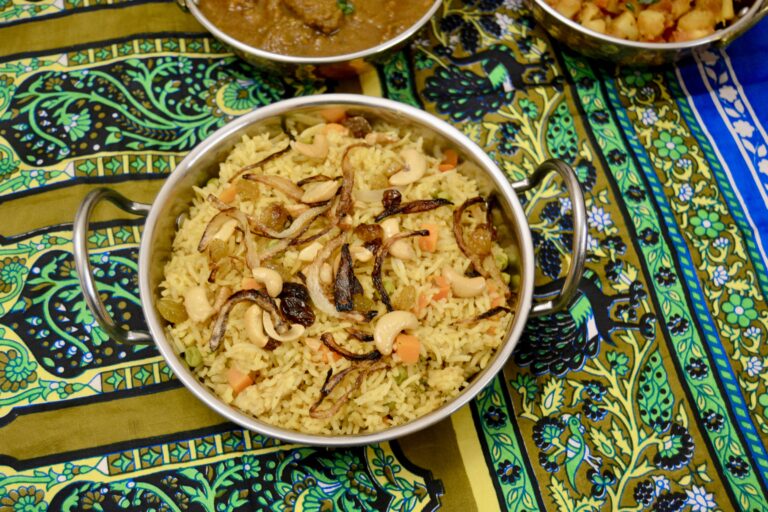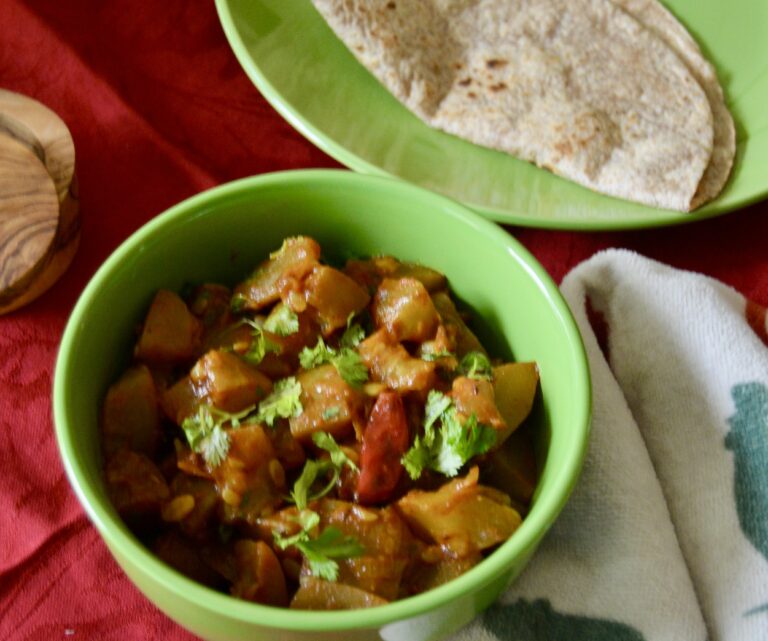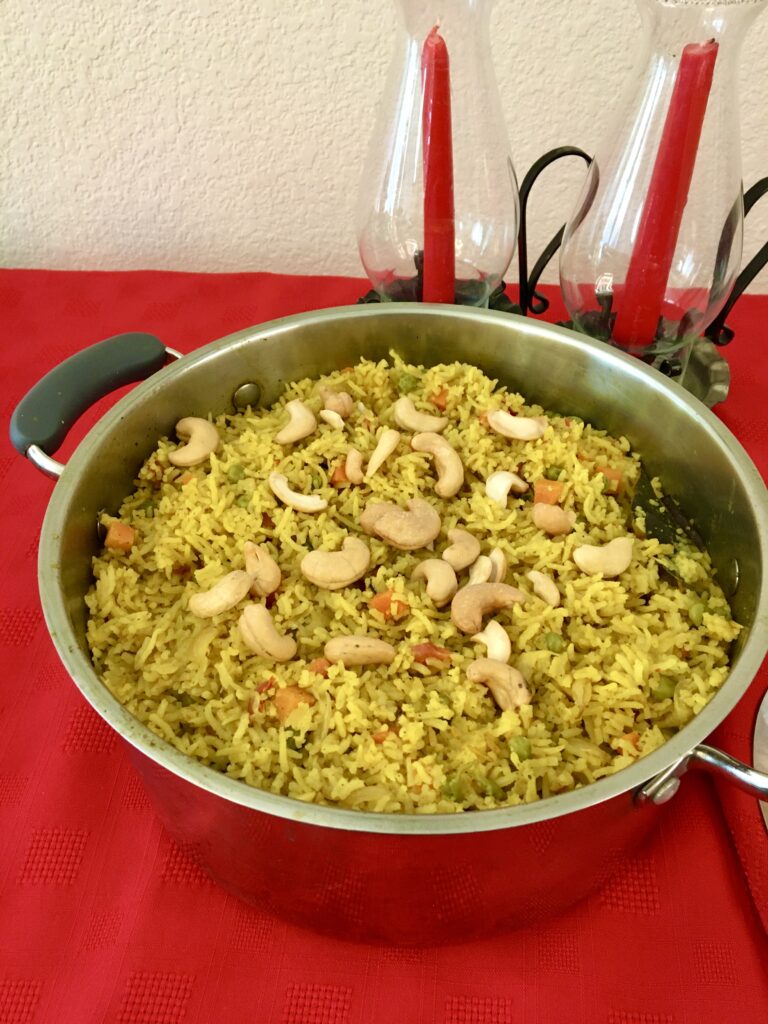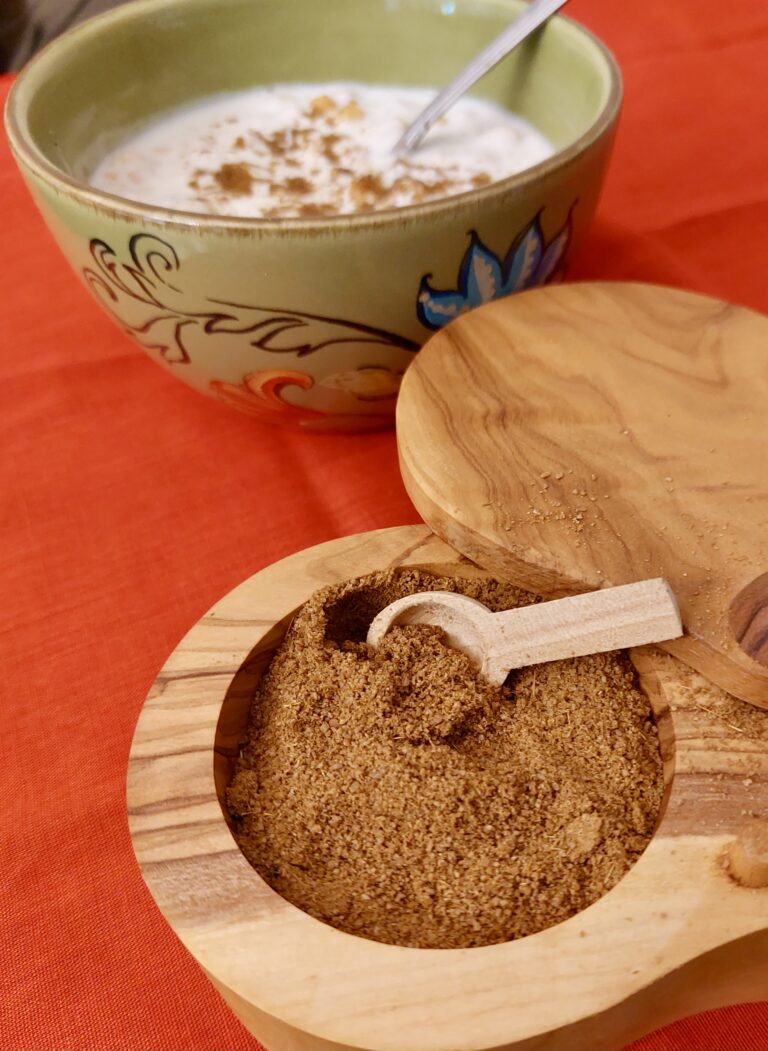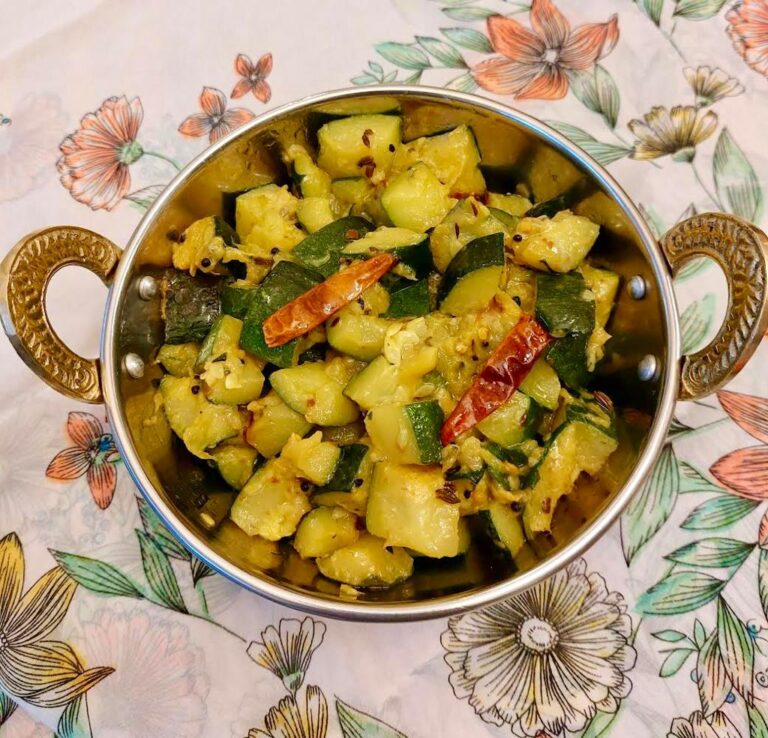My husband calls from his office at the Indian Air Force Headquarters, where he has been transferred. A colleague and his wife are driving in from Chandigarh and have an early morning flight from New Delhi. They have asked to stay with us overnight.
The armed services are a close-knit community, and you help each other whenever needed.
I take stock of dinner. Rosy (our cook) has already fixed the evening’s planned meat curry and sabzi. She will make fresh rotis when we are ready to eat. I decide to add a quick vegetable pilaf. Along with raita, pickles, and kuchumbar (Indian salsa), it would be a good dinner for hungry travelers. I head to the kitchen and call out to Rosy in her living quarters next to the kitchen. Together, we start fixing the pilaf and getting the table set for the two extra guests.
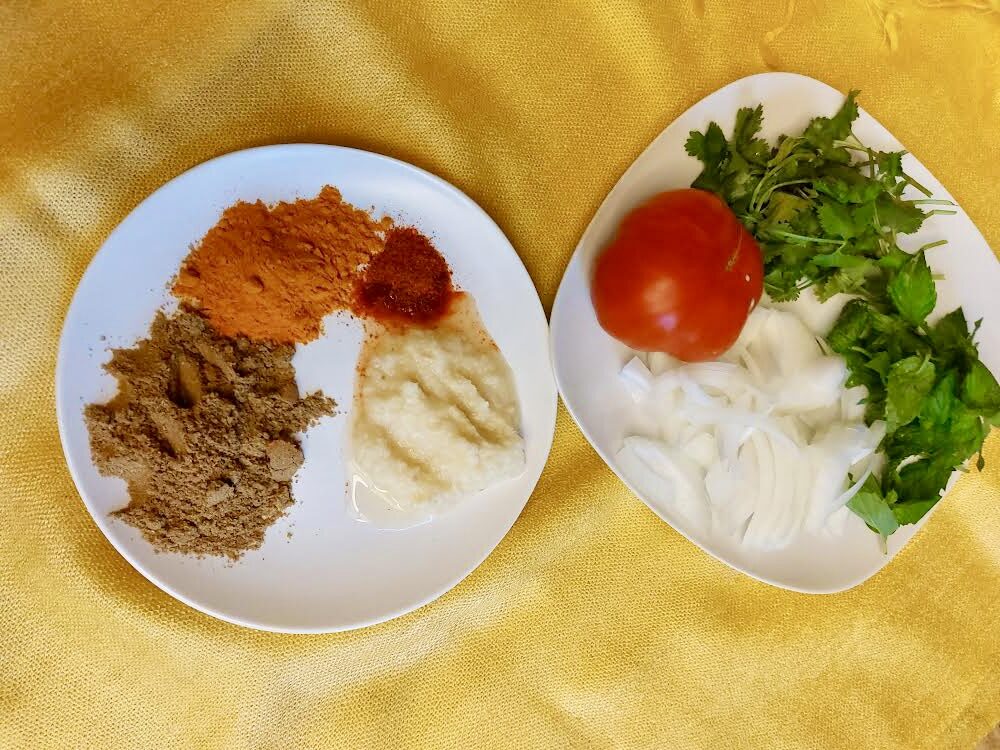
Vegetable Pilaf
Ingredients
- 3 cups Basmati rice (washed 4 times and soaked for 20 minutes )
- ¼ cup cooking oil (your choice)
- 2 medium Bay leaves
- 5 pepper corns
- 4 cloves
- 1 black cardamom
- 2 small green cardamoms
- 1 small cinnamon stick (about 1 inch)
- 2 whole Serrano green chilies (stem removed, slit half-way down the middle (optional))
- 2 medium onions (peeled and sliced thin)
- 1 tbsp fresh garlic paste (or you can use ready-made garlic and ginger paste)
- 1 tbsp fresh ginger past (or you can use ready-made garlic and ginger paste )
- 1 tsp turmeric powder
- 2 tsp coriander powder
- dash red chili powder (optional)
- ½ bunch fresh cilantro (pick leaves and a bit of the stem, grind to a paste or chop finely, about ¼ cup)
- 4 medium tomatoes (chopped or pureed coarsely)
- 1 cup mixed peas and carrots (I use a frozen pack )
- 3 cups vegetable broth
- Salt to taste
Garnish
- ½ sliced onion, cashew nuts, and raisins (all optional—or you could sprinkle the pilaf with some chopped cilantro/coriander leaves)
Instructions
- Heat oil in a large (6-quart) cooking pot over medium heat.
- Add whole spices and whole green chili. If you slit it midway down the center, it adds more heat to the curry. If you don't want that, just punch it once with a fork so it does not burst in the hot oil. Let it splutter for about 30 seconds, and then add the onions.
- Sauté the onions until they turn opaque and start to brown slightly at the edges. Stir occasionally so that the onions don't burn. About 4 minutes.
- Add ginger paste, garlic paste, and spice powders. Continue to sauté for an additional 2 minutes.
- Be sure to scrape the bottom of the pan to make sure nothing sticks and burns. Add the chopped tomato and cilantro.
- Cook, stirring frequently, until most of the moisture is absorbed and the oil starts to rise on the edges of the pan. About 10 minutes.
- Add the drained rice and carefully sauté it for about 3 minutes until the rice starts to turn opaque. Make sure it does not stick to the bottom of the pan and burn!
- Pour in the stock and water, stir, cover, and boil on medium heat. About 10 minutes.
- Add the peas and carrots and gently stir them in.
- Cover and cook on medium-low. When the water starts to evaporate and pits form on the top of the rice, reduce the heat to low. Cook another 5-6 minutes.
- Check a few grains of rice to see if the rice is done by pressing a grain between the thumb and forefinger. If it is still gritty, cover it and cook on low heat for 2 minutes more.
- Turn the heat off and let sit for 5 minutes. Fluff rice with a fork.
- Serve on a rice platter or serving dish and garnish with sauteed onions, cashews, raisins, or chopped fresh cilantro/coriander.
- This makes for a satisfying meal paired with raita. It also goes well with any curried lentil, or vegetarian or non-vegetarian curry, or with any style raita.
Notes
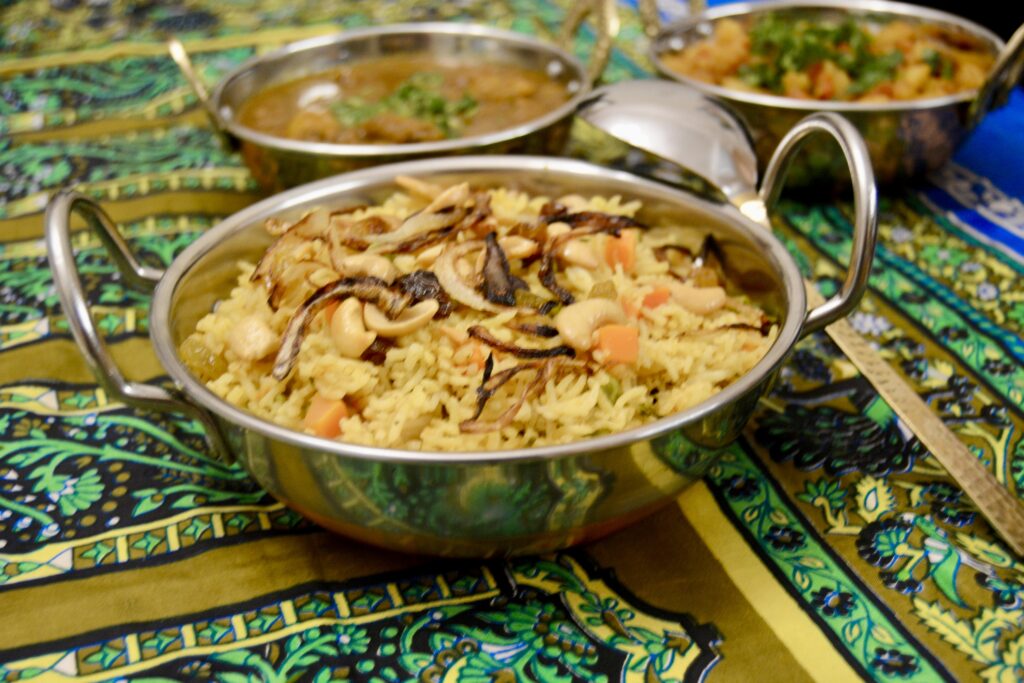
Bottle Gourd or Opo Squash, also known in India as lauki, ghiya, dudhi, sorakkai, etc., is a summer vegetable that is used in a variety of Indian dishes. It is made into sabzis (sautéed vegetables), and curries, and incorporated into dals. The squash is a savory, healthy vegetable rich in nutrients. It is a good pick-me-up when you are feeling under the weather.
When picking lauki, be sure to check for firmness. If it feels slightly soft or browning, it is over-ripe, and it is best to avoid it for cooking.
This recipe is a Punjabi-style simple lauki sabzi, which I adapted from watching my mother-in-law cook. She would often cook it minus the onions or sometimes minus both the onions and tomatoes.
Since bottle gourd can be quite bland, the spices and tomatoes give it a nice, savory, tangy flavor.
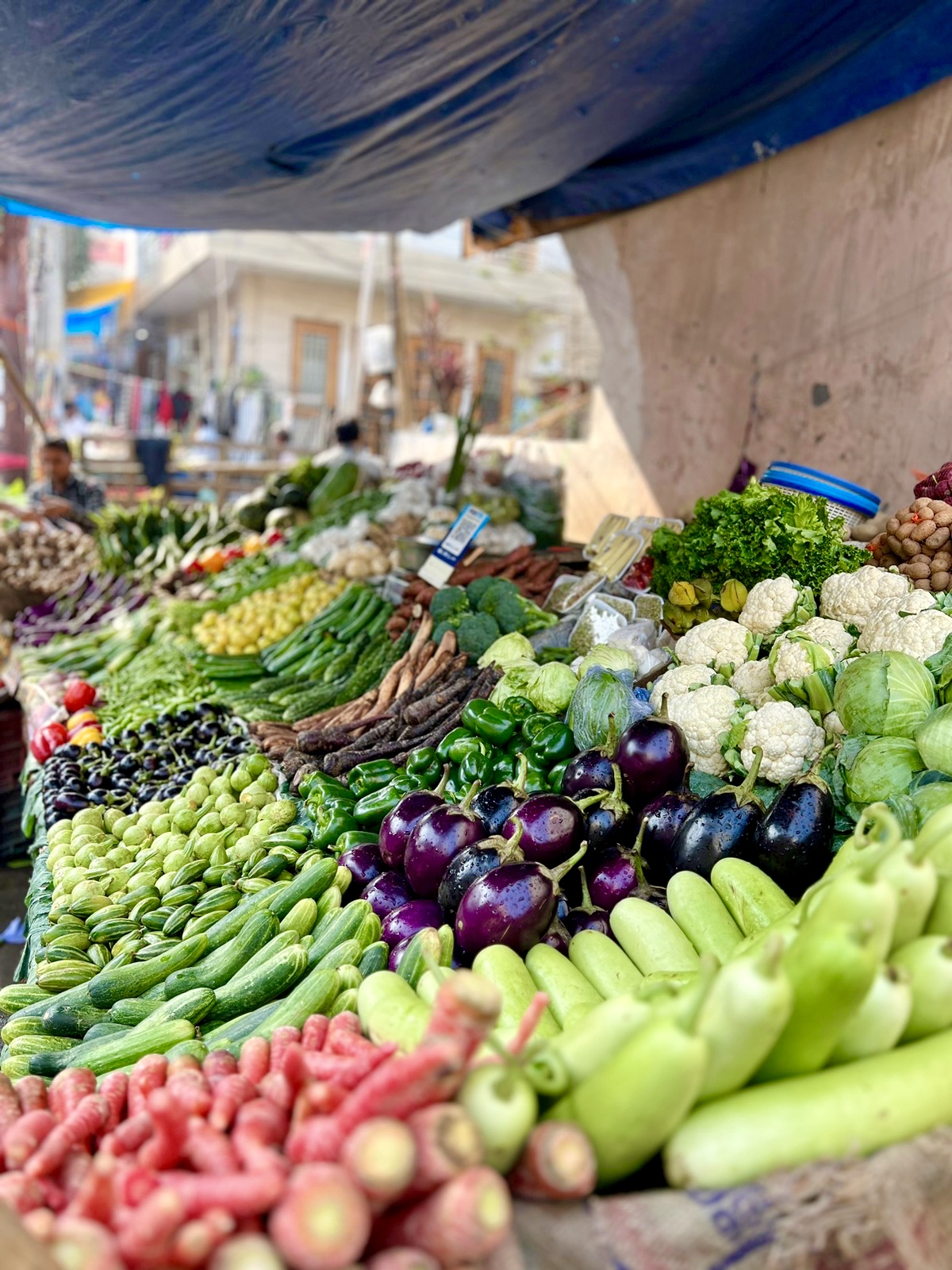
Lauki Sabzi (Bottle Gourd Sautéed in Spices)
Ingredients
- 1 medium lauki (gourd) (approximately 3 cups )
- 3 tbsp cooking oil
- 1 whole red chili (optional)
- ½ tsp whole cumin seeds
- 2 tsp ginger, chopped
- 1 medium onion, diced (about ¾ cup)
- ½ tsp turmeric powder
- ½ tsp red chili powder or red chili flakes (adjust to your taste)
- 2 medium tomato, diced fine (or 2 tbsp tomato paste)
- 2 tsp ghee or butter
Garnish
- ½ tsp garam masala
- 1 tbsp chopped cilantro / coriander leaves
Instructions
To Prepare
- Wash the gourd, cut both ends, and peel the skin.
- Cut it lengthwise into half and then again in half.Remove any seeds. There is no harm if a few remain. Chop the gourd into bite-size cubes.
- Set aside in a bowl of water.
To Cook
- Turn on the stove to medium heat, place a wok, skillet, or frying pan on the stove. Add the oil until heated.
- Add the whole red chili and swirl it around in the oil until it darkens, about 30 seconds. The fumes are pungent, so be careful if you don't want to cough!
- Add the cumin seeds (careful of splutter).
- When slightly brown (about30 seconds), add the chopped ginger. Stir for 30 seconds and add the onions. Sauté for 4-5 minutes.
- Now add the turmeric and chili powder. Give it a quick stir, then add the chopped tomatoes. Cook till the oil starts to surface, 5-7 minutes. If you are using the tomato paste, it takes about 2 minutes.
- While the tomatoes are cooking, drain the gourd in the bowl of water bowl and set aside.
- Once the oil surfaces on the onion tomato mixture (masala), add the gourd.
- Stir well for about 2-3 minutes until the gourd is nicely coated with the masala. Cover, reduce heat to medium low and cook, stirring occasionally for approximately 15 minutes until the gourd is fork tender.
- The gourd should release enough of its own moisture to cook in, but you can add ¼ cup of hot water if it appears to be drying out before it is cooked.
- Uncover and check the lauki to see if it is done and that the oil is surfacing on the sides.
- Now add the 2 teaspoons of ghee. Stir the sabzi. Cover and remove from heat.
- Transfer to a serving dish.
- Garnish with the cilantro and garam masala.
Notes

This recipe is morphed from Mama’s Biryani recipe. Sometimes, I would serve Vegetarian Biryani instead of Biryani with meat or chicken. This saved me the hassle of fixing two types of pilafs for a lunch or dinner party. I would pair it with channa dal, two different styles of sabzis (Indian sauteed vegetables), a paneer curry, and a non-vegetarian dish. Along with that came the usual array of pickles, raita, and rotis. It made quite a meal!
There is a less elaborate Vegetarian Pilaf, which I shall share as well.
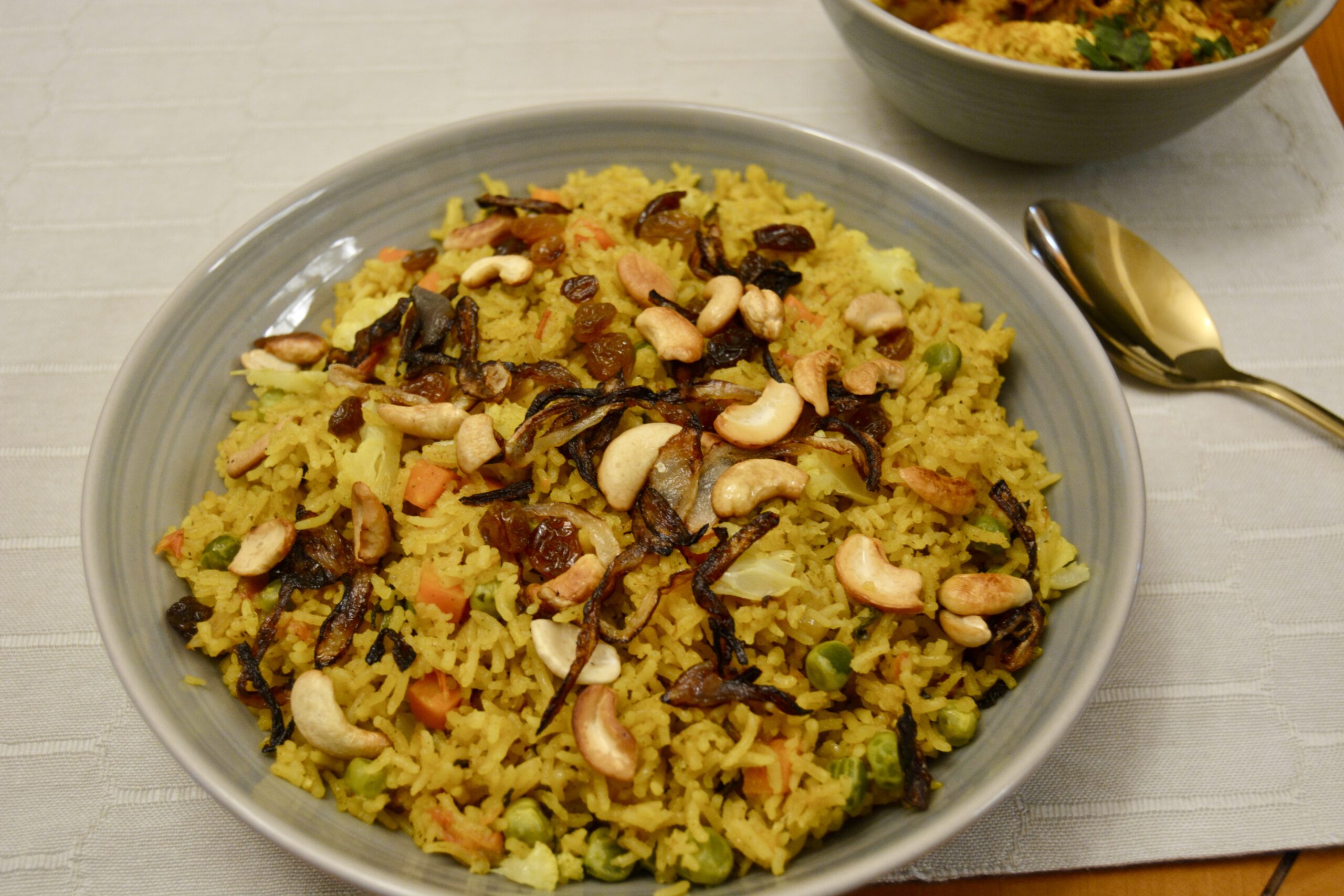
Vegetable Biriyani
Ingredients
- 5 cups Basmati rice
- ½ cup oil (plus a little extra, if needed)
- 2 Bay leaves
- 4 cinnamon sticks (or ½ tsp cinnamon powder)
- 1 large black cardamom
- 6 small green cardamoms
- 6 cloves (or ¼ teaspoon clove powder)
- 3 large onions (peeled, cut in half, and sliced thin)
- 2 medium Serrano chilies (washed, remove stem, and slice in half)
- 3 tbsp ginger paste (freshly ground is best, but ready-made is fine, too)
- 2 tbsp garlic paste (freshly ground is best, but ready-made is fine, too)
- ½ cup fresh green coriander ground fine (mainly leaves, but a portion of stem is okay)
- 3 tbsp coriander powder
- 1 tsp turmeric powder
- 1 tsp red chili powder (or to your taste—remember this and the green chilies will add heat to the pilaf)
- 6 medium tomatoes (finely chopped or puréed)
- 1 tbsp poppy seeds ground smooth (optional)
- 1 can coconut milk (or the fleshy, white part of 1 fresh coconut ground smooth with the poppy seed)
- 8 cups water (plus a little extra)
- 2 cups peas and diced carrots (you may combine it with other vegetables such as cauliflower, cut into flowerets, or diced beans)
- 2 tbsp mint leaves (finely chopped)
- 2 tbsp chopped fresh green coriander leaves
- Salt (to taste)
- 2 limes (juice only)
Garnish
- ½ onion (or use pre-fried store-bought onions to make it easy)
- sautéed cashews (or use cocktail cashews)
- sautéed raisins
Instructions
To Prepare
- Gather all the ingredients before you start.
- Wash and soak the 5 cups of rice for 15-20 minutes. Drain and set aside.
- Mix coconut milk, ground poppy seed(optional), and 8 cups water.
- Together they should measure 10 cups plus 2 tablespoons of liquid.
- Combine chopped mint leaves and coriander leaves with the juice of 2 limes in a small bowl.
To Cook
- Heat ½ cup of oil in an 8-quart heavy-bottomed pot on medium heat. You may need a tablespoon or two extra as you start to sautée.
- Add the whole Bay leaf cinnamon, cardamom, and cloves.
- Add cut onions and slit green chilies.
- When half-fried (about 6 minutes), add the ground ginger, garlic, spice powders (including the ground cinnamon and cloves, in case you decided to use them instead of the whole ones), and green coriander paste.
- Fry for about 3-4 minutes until fragrant, then add the chopped and pureed tomatoes. Sauté for another 5 minutes.
- Now add the drained rice and sauté on medium heat, stirring carefully to not break up the rice grains. About 2-3 minutes.
- Pour in the water, coconut milk, and salt. Cover and bring to a boil.
- Once the water starts to boil (10-15 minutes), add the vegetables and cook on medium-low until the water is almost evaporated and you see little pits on top of the rice.
- Stir gently. Sprinkle the chopped mint, coriander, and lemon mix over the rice.
- Put on low and cook another 10 minutes until the pits disappear on top and the rice is cooked. You can test by testing a grain between your thumb and forefinger. If it's grainy, let it cook for a little more, but make sure the underside is not getting burnt.
- Fluff with a fork and plate on a rice platter or serving dish.
- Garnish with sauteéd onions, cashews, and raisins.
Notes
There are certain spice blends that I fix and keep on hand as I use them frequently. One of them is toasted cumin. This aromatic spice adds a unique flavor to a dish. It is easy to fix and used as a topping in many dishes such as your raitas (yogurt relishes), chaats (street food), dals (lentils), and sabzi( sautéed vegetables). It is also added to some curries, tikkas, and kebabs.
Easy to fix, you can store it for several months.
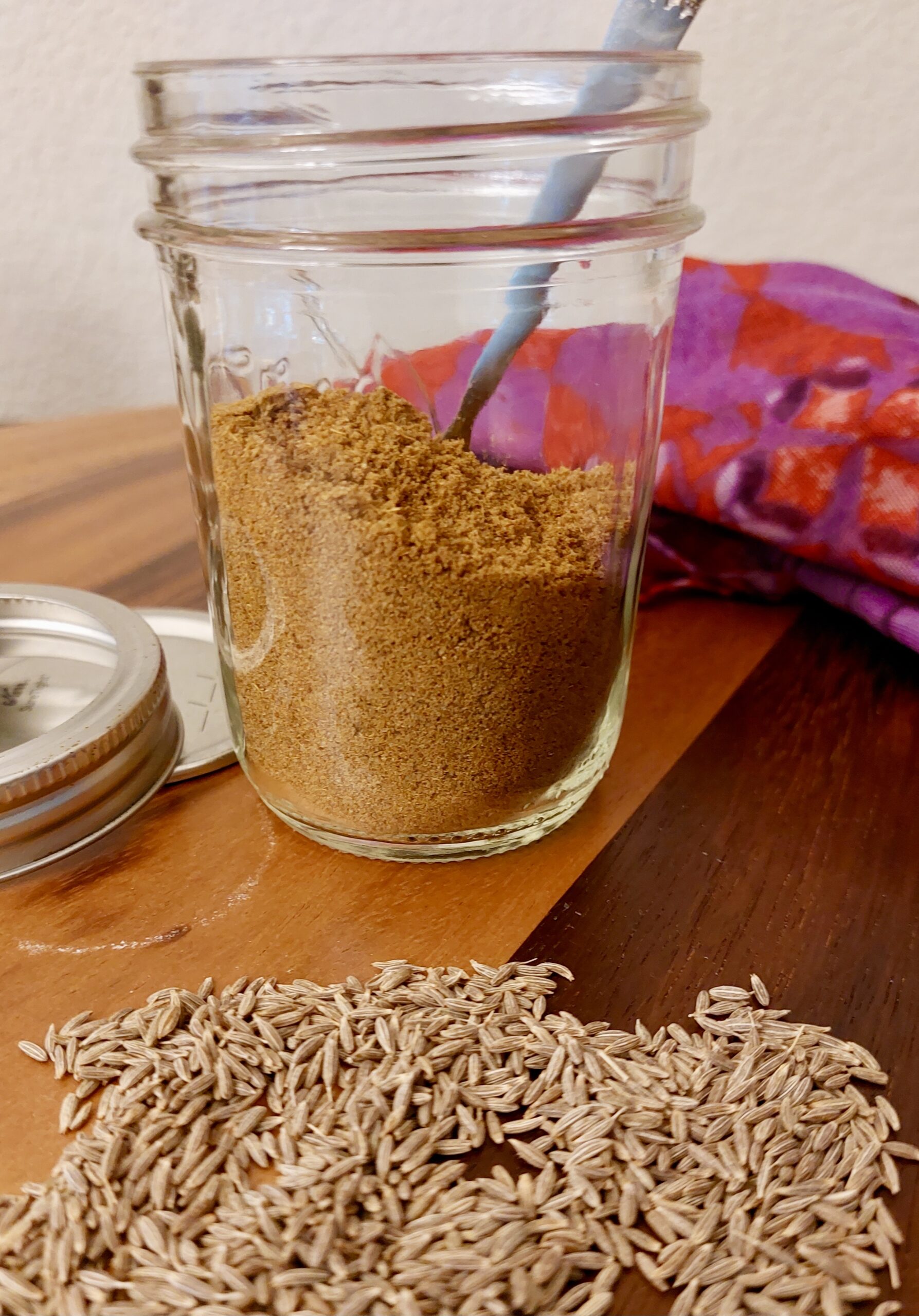
Bhuna Jeera (Roasted Cumin Powder)
Ingredients
- ½ cup cumin seeds
Instructions
- Pick and clean your cumin seeds on a light-colored plate, as this shows dirt particles better, making cleaning easier.
- Once cleaned, set aside the cumin seeds.
- Heat your tava (Indian griddle) or a heavy-bottomed skillet on low-medium heat.
- Add the cumin seeds to the dry pan. Toast the seeds, stirring continuously for approximately 2 minutes until fragrant and the seeds are a shade darker.
- Important: Do not over-brown, as this will give the seeds a burnt taste.
- Pour into a bowl and cool completely.
- Place the seeds in a spice or coffee grinder/blender and blend to a fine powder.
- You can also use a pestle and mortar if you don't have a coffee grinder/blender. Grind to a fine powder.
- Store the powder in a clean, dry glass bottle with a tight lid.
Notes

We are back from a ten-day vacation. My vegetable garden is relatively new, and I am anxious to check how it has fared with only the timed sprinklers watering it.
Not bad!
The plants are still alive, and the two zucchini plants I cultivated are spread thickly over the plot. Peeping out from under the foliage, I spy a bit of zucchini. I pull at the fruit. It is over one foot long. It is the largest I have seen, and it has a companion. These were just beginning to grow when we left on our trip. That’s when I learned that zucchini grows very fast, so it’s a good idea to keep an eye on them when they grow so you can harvest them young and tender.
The Indian equivalent of zucchini is a gourd called Toree. It has a mild, slightly sweet flavor. Like most squashes, it takes on the flavor of the seasonings and spices it is cooked in.
I cook zucchini with a five-seed seasoning called panch pooran (five seeds). I add a little heat to this dish to counter the slight sweetness of the zucchini. Panch Pooran seasoning is available at Indian grocery stores, but I have included a recipe for it in the notes. It goes good with squashes and cabbage.
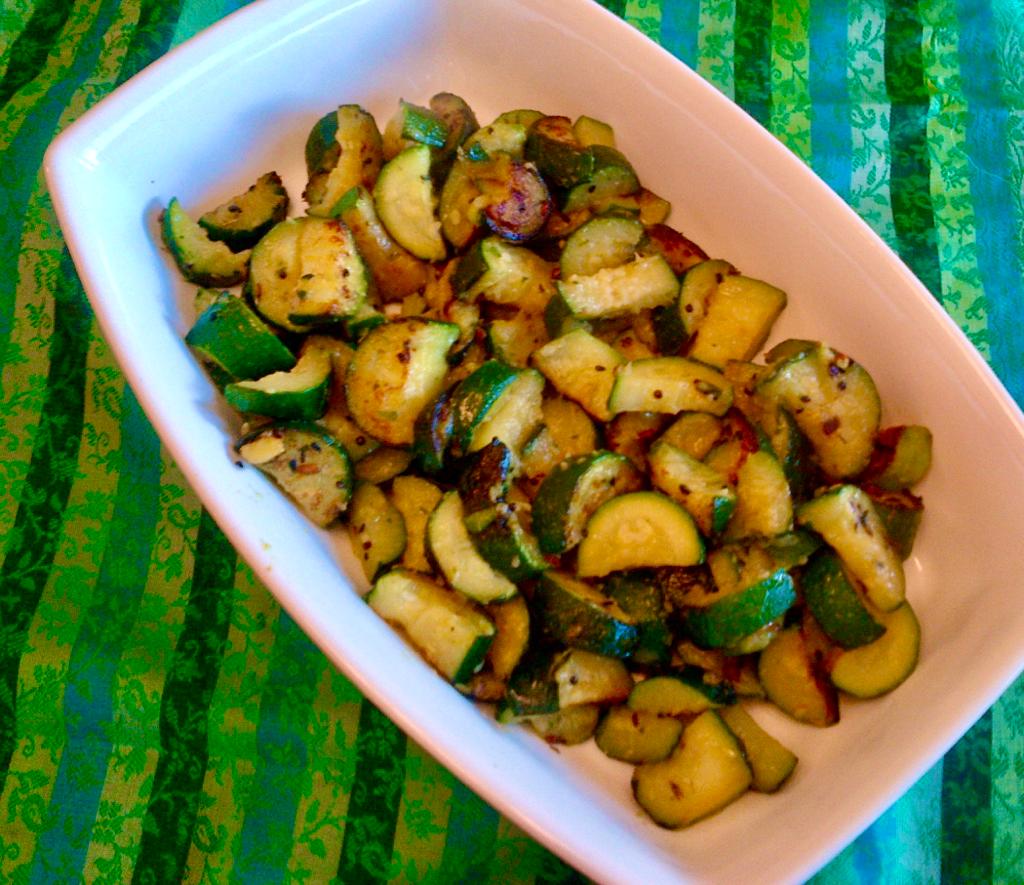
Tori Panch Pooran Sabzi (Five-Seed Zucchini Vegetable)
Ingredients
- 4-6 medium zucchini
- 1 tsp 5-seed seasoning
- 1-2 small dry red chilies (more or less, to your taste)
- ¼ tsp red chili flakes (more or less, to your taste)
- ½ tsp turmeric powder
- ½ tsp salt (more or less, to your taste)
- 2 tbsp cooking oil
Panch Pooran Tadka
- 1 tsp mustard seeds
- 1 tsp coriander seeds
- 1 tsp fennel seeds
- ½ tsp fenugreek seeds
- ½ tsp onion seeds (you can substitute 1 tsp cumin seeds for the onion sees.)
Instructions
- Wash the zucchini. Cut the stalk end. Split the zucchini in half length-wise and then again in half length-wise. Chop into bite-sized bits. Don't cut the bits too small, as they get squishy fast.
- In a wok or skillet, heat the oil on medium heat. Lower heat to medium-low and add the red chilies, give them a stir, and let them darken for about 30 seconds. They are pungent, so don't inhale, or you will start coughing!
- Add the five-seed seasoning, wait 30 seconds for it to crackle and pop, then quickly add the turmeric powder.
- Stir for a few seconds before adding the zucchini.
- Stir until the zucchini is nicely coated.
- Turn the heat up to medium and cook uncovered, stirring occasionally, until the zucchini is done(approximately 10-15 minutes).
- You can leave the vegetable crunchy or soft to your liking. You do not have to add water as the zucchini releases enough moisture to cook in.
- This dish goes well in a wrap or as a side with roti, dal, or rice.
Panch Pooran Tadka
- Toss all the ingredients together and store them in ajar.
- Fenugreek is a bitter seed; if you are not used to it, you can reduce it to 1/4 teaspoon.
- Panch Pooran can be used when fixing different squashes and cabbage.
Notes
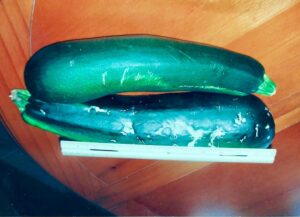
It is the winter holidays, and school is out. Dad is stationed in Calcutta. Dad and Mom’s social life is pretty hectic. Nanny watches us like a hawk when they are out for cocktails, dinner, or at the club.
Daniel, our cook, is prepping for a pre-Christmas party. Some of us, older siblings, have helped him beat the eggs for the vanilla cake and are fascinated as he slowly places the cake in a large round tin half filled with sand sitting on top of the sigiri (a clay stove fueled with coal).
Daniel tests to see if the sand is hot enough. He then slowly sets the cake pan in the middle of the drum on top of the sand. He then covers it with a fitted lid and places hot coal on top. This way of cooking was the method that Daniel preferred to use to bake our cakes, and they always turned out delicious.
In those days, other than clubs, restaurants, and military dining halls, ovens (other than tandooris) were not widely used in Indian homes since most Indian cuisine did not require it. The local bakeries, schooled under the British Raj with recipes handed down for generations, baked some of the best pastries and cakes I have ever eaten. They would also oblige families by baking any homemade cakes in their ovens upon request—and for a fee, of course!
With time, stovetop and small electric ovens found their way into homes. Baking ovens have now become a necessity in most urban Indian homes.
I used to bake cakes from scratch, but when I moved to the US, I took the easy way out and used packaged cake mixes. The one that I like best is the Super Moist Yellow Cake Mix. My twin was in town one holiday season when I prepared to bake the cake. She suggested I substitute some water with rum and fix a rum cake.
The Rum Cake became a big hit at potlucks, church gatherings, dinners, and as baked gifts to my neighbors for Christmas. Thank you, Twin!
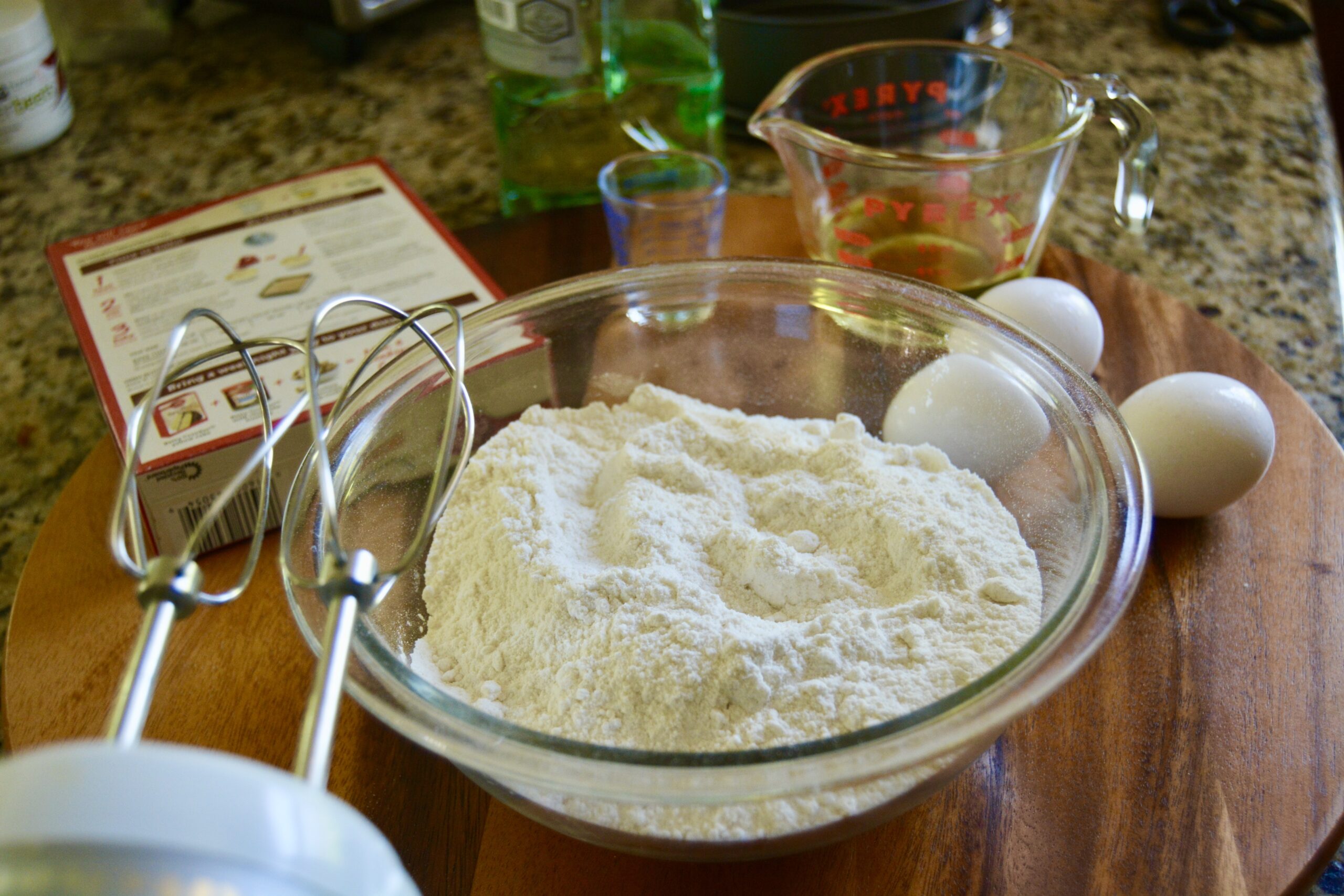
Rum Cake
Ingredients
- 1 box yellow cake mix (I like Betty Crocker's Super Moist Yellow Cake or Duncan Hines Classic Yellow Deliciously Moist Cake)
- ½ cup vegetable oil (Please check the instructions on box to see the exact amount of oil needed as it may differ)
- 3 eggs
- ¾ cup water
- ¼ cup rum (Ensure it is an excellent strong rum, white or dark)
- powdered sugar (for dusting the cake - more or less, per your taste)
- dash cake sprinkles
Instructions
Yellow Cake
- Prepare according to the instructions on the box.
- Keep an eye on the cake towards the end to ensure it does not dry out. I generally stick a bamboo skewer into it 5 minutes before the bake time. If it comes out clean, I remove it from the oven and allow it to cool.
- Once cool, dust it with the powdered sugar and decorate the top with sprinkles.

